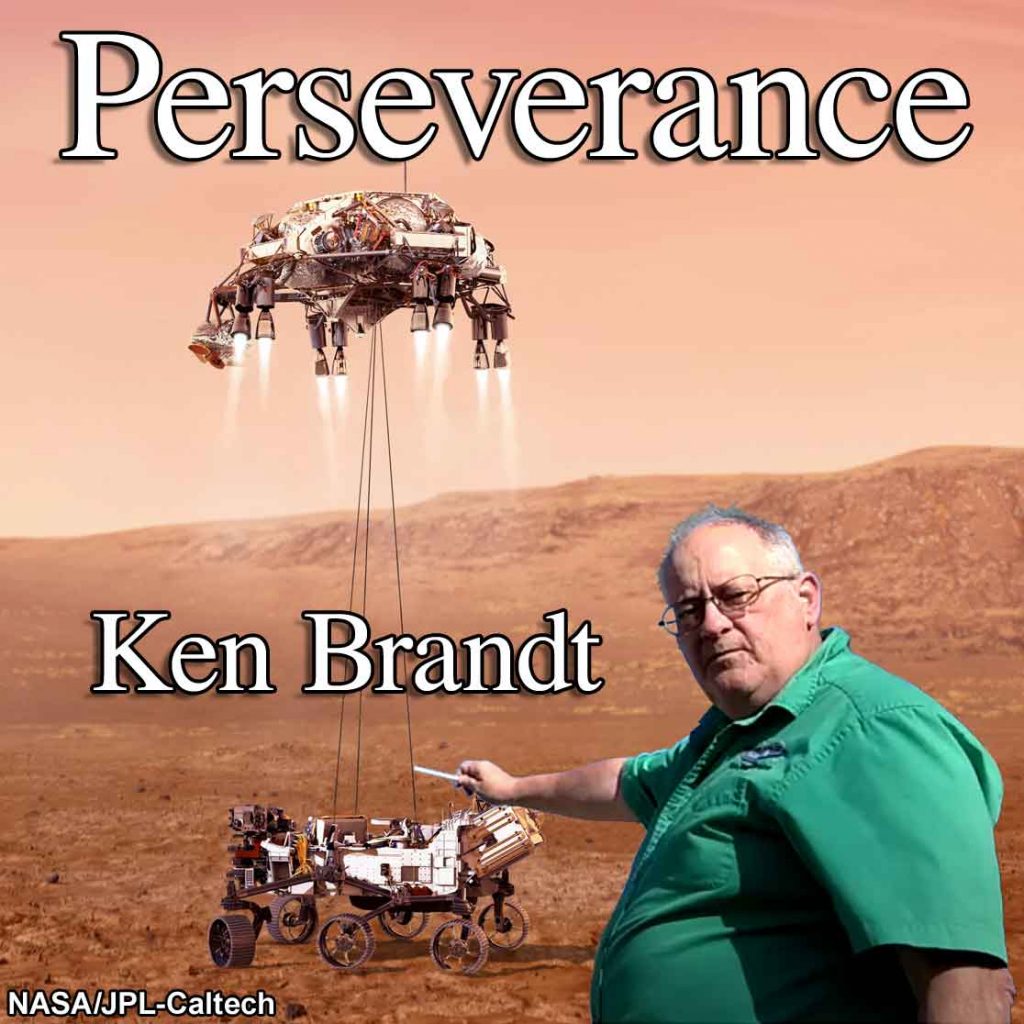Podcaster: Ken Brandt

Title: What Makes Perseverance Different?
Organization: Robeson Planetarium/JPL Solar System Ambassador
Link: https://www.robeson.k12.nc.us/o/robeson/page/robeson-planetarium
Description:
What makes Perseverance different than previous Rovers?
Perseverance is NASA’s latest robot to explore Mars. Hopefully, at 3:55 PM EST, Perseverance will land gently onto the lakebed floor of Jezero crater.
Let’s begin by talking about the Entry, Descent, and Landing of this rover. Much more precise than the landing system on Curiosity, Perseverance features a number of innovations.
Bio: Ken Directs the Robeson Planetarium in rural North Carolina. He is also a volunteer in NASA/JPL’s Solar System Ambassador program, which is a national network of passionate volunteers who explain and educate about space exploration for their audiences.
Today’s sponsor: Big thanks to our Patreon supporters this month: Dustin A Ruoff, Brett Duane, Kim Hay, Nik Whitehead, Timo Sievänen, Michael Freedman, Paul Fischer, Rani Bush, Karl Bewley, Joko Danar, Steven Emert, Frank Tippin, Steven Jansen, Barbara Geier, Don Swartwout, James K. Wood, Katrina Ince, Michael Lewinger, Phyllis Simon Foster, Nicolo DePierro, Tim Smith.
Please consider sponsoring a day or two. Just click on the “Donate” button on the lower left side of this webpage, or contact us at signup@365daysofastronomy.org.
Please visit our Patreon page: https://www.patreon.com/365DaysOfAstronomy
or you can consider to sponsor a day of our podcast : https://cosmoquest.org/x/365daysofastronomy/product/sponsor-an-episode-of-365-days-of-astronomy/
Transcript:
Perseverance is NASA’s latest robot to explore Mars. Hopefully, at 3:55 PM EST, Perseverance will land gently onto the lakebed floor of Jezero crater.
Let’s begin by talking about the Entry, Descent, and Landing of this rover. Much more precise than the landing system on Curiosity, Perseverance features a number of innovations. Range trigger is a software that will enhance parachute opening, bringing Perseverance closer to its ideal landing site. Terrain relative navigation uses the rover’s downlook camera to snap images of the surface, and quickly compare them to previously assembled orbital images of the same terrain using the onboard computer. The rover can then fire its retrorockets in order to steer clear of landing hazards, similar to when Neil Armstrong steered clear of a boulder field Eagle was headed for on the moon.
Once safely on the ground, the rover’s instruments begin to interrogate mars as never before.
The chemin instrument is a laser that will pierce the surface of selected rocks, while an x-ray spectrometer looks at the resulting vapor. In this way, rocks can be analyzed up to a distance of 30 feet away.
Sherloc, Watson, and PIXL are three spectrometers located on the end of the robotic arm. They use different wavelengths of light to analyze the mineral composition of rocks, and determine if organic matter is present.
Two microphones on the rover will document the sounds of landing on, and exploring Mars. These microphones will document the sound of Entry, descent, and landing; along with the day-to-day grind of exploration. Wheel and motor function can be analyzed by the pitch of the motors. When the laser or drill is interrogating a sample, the noise that rock makes while being drilled or blasted can tell you a lot about the interior structure of the rock, as well as the resistance of its surface.
Rimfax is a ground-penetrating radar that can “see” 200 feet down. This will help determine the subsurface structure of the rocks, as well as finding out if there is ice or liquid water under the rover.
MEDA and Moxie are two instruments that are specifically paving the way for future human exploration of Mars. MEDA is a weather station that will, in addition to gathering basic weather information, also gather information about Martian dust grains. This information will enhance the design of shielding on future human habitats. Moxie is designed to take Carbon Dioxide out of the Martian atmosphere, and convert it to Oxygen. Of course Mars colonists will need Oxygen to breathe, but Oxygen is also useful as rocket fuel. Moxie is one example of a technology test of equipment that will enable In-situ resource utilization-using mars materials to assist colonists.
Another technology demonstration test is the Mars helicopter, Ingenuity. Ingenuity is a 4 pound simple design machine that includes a camera, radio, computer, and, of course, rotors and the motors to power them. Solar powered, it will be launched on five test missions shortly after Perseverance lands.
Perseverance, in addition to studying the rocks with its suite of instruments, cameras, and spectrometers, will also be taking up to 40 sample tubes of Martian soil and rock, leaving them in its wake for a future sample return mission to hoist back to Earth. There, the samples can be examined with the finest equipment available here, that you just can’t pack onto a car-sized robot going to Mars.
All together, these instruments and equipment should provide plenty of data, along with some cool visuals and audio from Mars. I can’t wait to see how this mission unfolds! To follow along, go to https://mars.nasa.gov/mars2020/ . There, new images, video, audio, and mission updates will be posted daily.
End of podcast:
365 Days of Astronomy
=====================
The 365 Days of Astronomy Podcast is produced by Planetary Science Institute. Audio post-production by Richard Drumm. Bandwidth donated by libsyn.com and wizzard media. You may reproduce and distribute this audio for non-commercial purposes.
This show is made possible thanks to the generous donations of people like you! Please consider supporting to our show on Patreon.com/365DaysofAstronomy and get access to bonus content.
After 10 years, the 365 Days of Astronomy podcast is poised to enter its second decade of sharing important milestone in space exploration and astronomy discoveries. Join us and share your story. Until tomorrow! Goodbye!

